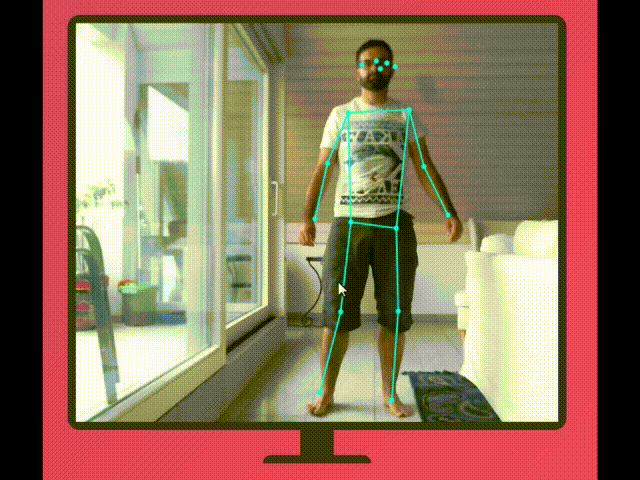This is an example of using pre-trained models in the browser. For this particular example, this is a trained MobileNet model, an efficient CNN for mobile vision. PoseNet can detect human figures in images and videos using either a single-pose or multi-pose algorithm. For more details about this Machine Learning model, refer to this blog post for a high-level description of PoseNet running on Tensorflow.js.
See demo here
Notes:
- This code is based on tfjs-models/posenet model released by TensorFlow team. I borrowed, adapted and turned it into a React component.
- Keep in mind I just tested it in Chrome. Honeslty, I don't care about other browsers for this kind of experiments.
- You must allow, for obvious reasons, the use of your webcam. Don't worry, the images stay in your browser. Let's say it's GDPR compliance 😜
import * as React from 'react'
import ReactDOM from 'react-dom'
import PoseNet from './PoseNet'
ReactDOM.render(
<PoseNet
{/* Default value: 600 */}
videoWidth={ 600 }
{/* Default value: 500 */}
videoHeight={ 500 }
{/*
If the poses should be flipped/mirrored horizontally.
This should be set to true for videos where the video
is by default flipped horizontally (i.e. a webcam), and
you want the poses to be returned in the proper orientation.
Default value: false
*/}
flipHorizontal={ false }
{/*
There are two possible values: 'single-pose' | 'multi-pose'.
Default value: 'single-pose'
*/}
algorithm={ 'single-pose' }
{/*
Loads the PoseNet model weights for either the 0.50, 0.75,
1.00, or 1.01 version. They vary in size and accuracy. 1.01
is the largest, but will be the slowest. 0.50 is the fastest,
but least accurate.
Default value: 1.01
*/}
mobileNetArchitecture={ 1.01 }
{/* Default value: true */}
showVideo={ true }
{/* Default value: true */}
showSkeleton={ true }
{/* Default value: true */}
showPoints={ true }
{/*
The overall confidence in the estimation of a person's
pose (i.e. a person detected in a frame)
Default value: 0.1
*/}
minPoseConfidence={ 0.1 }
{/*
The confidence that a particular estimated keypoint
position is accurate (i.e. the elbow's position)
Default value: 0.5
*/}
minPartConfidence={ 0.5 }
{/*
The maximum number of poses to detect.
Default value: 2
*/}
maxPoseDetections={ 2 }
{/*
Non-maximum suppression part distance. It needs to be strictly positive.
Two parts suppress each other if they are less than nmsRadius pixels away.
Defaults value: 20
*/}
nmsRadius={ 20.0 }
{/*
Must be 32, 16, or 8. This parameter affects the height and width
of the layers in the neural network. At a high level, it affects
the accuracy and speed of the pose estimation. The lower the value
of the output stride the higher the accuracy but slower the speed,
the higher the value the faster the speed but lower the accuracy
*/}
outputStride={ 16 }
{/*
Values between 0.2 and 1. Scales down the image and increase
the speed when feeding through the network at the cost of accuracy.
Default value: 0.5
*/}
imageScaleFactor={ 0.5 }
{/* Default value: 'aqua' */}
skeletonColor={ 'aqua' }
{/* Default value: 2 */}
skeletonLineWidth={ 2 }
{/* Default value: 'Loading pose detector...' */}
loadingText={ 'Loading pose detector...' }
/>,
document.getElementById('app')
)$ npm install
$ npm run example
Browser will open http://localhost:8080/. Have fun 😉
$ npm install jscriptcoder/tfjs-posenet
import * as React from 'react'
import PoseNet from 'tfjs-posenet'
const MyContainer = (props) => (
<div>
<h3>This is my container<h3>
<PoseNet
videoWidth={props.width}
videoHeight={props.height}
skeletonColor={props.color} />
</div>
)